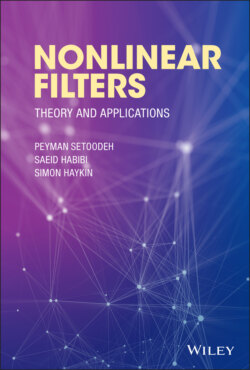Читать книгу Nonlinear Filters - Simon Haykin - Страница 22
2.5.1 Continuous‐Time LTV Systems
ОглавлениеThe state‐space model of a continuous‐time LTV system is represented by the following algebraic and differential equations:
(2.36)
(2.37)
In order to determine the relative observability of different state variables, we investigate their contributions to the energy of the system output. Knowing the input, we can eliminate its contribution to the energy of the output. Therefore, without loss of generality, we can assume that the input is zero. Without an input, evolution of the state vector is governed by the following unforced differential equation:
(2.38)
whose solution is:
(2.39)
where is called the continuous‐time state‐transition matrix, which is itself the solution of the following differential equation:
(2.40)
with the initial condition:
(2.41)
Note that for an LTI system, where the matrix is constant, the state transition matrix will be:
(2.42)
Without an input, output of the unforced system is obtained from (2.37) as follows:
(2.43)
Replacing for from (2.39) in the aforementioned equation, we will have:
(2.44)
whose energy is obtained from:
(2.45)
In the aforementioned equation, the matrix in the parentheses is called the continuous‐time observability Gramian matrix:
(2.46)
From its structure, it is obvious that the observability Gramian matrix is symmetric and nonnegative. If we apply a transformation, , to the state vector, , such that , the output energy:
(2.47)
can be rewritten as:
(2.48)
If the transformation is chosen in a way that the transformed observability Gramian matrix, , is diagonal, then, its diagonal elements can be viewed as the contribution of different state variables in the initial state vector to the energy of the output. The continuous‐time LTV system of (2.36) and (2.37) is observable, if and only if the observability Gramian matrix is nonsingular [9, 14].
